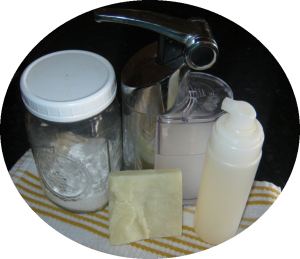Natural Year Challenge: Household - Month Three
 Make Household Soaps
Make Household Soaps
Welcome to the third step of our Natural Year Challenge! This month we'll continue our transition to natural, chemical-free cleaning products by making our own household soaps. If you've purchased all five supplies from our Month One Challenge, you're ready to create your own liquid dish soap, dishwasher powder, hand soap, and more!
Liquid Dish Soap
You can either purchase a pump dispenser or reuse a squeeze bottle filled with your very own creation!
Ingredients:
- Liquid castile soap
- Filtered water
- Essential oil of choice (optional)
Combine liquid castile soap with filtered water. The ratio of soap to water depends on personal preference. Begin with a ratio of 1 part liquid castile soap to 6 parts water and adjust as needed. For extra suds, add 1-2 tablespoons of glycerin. If desired, add several drops of essential oil such as lavender, tea tree, or lemon.
This recipe can be adapted for bar soap. Grate 1 oz. of castile bar soap. (Our momsAWARE Online Store offers an excellent all-natural castile soap in both bar and grated forms.) Pour 1-2 cups of boiling water over soap and allow to dissolve. This is a simple version of liquid castile soap. (True liquid castile is made with potassium hydroxide, as opposed to the sodium hydroxide used in bar soap. We will be learning how to make liquid soap in our Month Ten Challenge.) Combine as instructed above. Experiment until you find a ratio that works for you.
For added cleaning power when dishes are especially greasy, add 1/2 cup vinegar or lemon juice to the dishwater. To loosen burned-on foods from pots, add baking soda or washing soda combined with water and allow to soak for 15 minutes or overnight, if desired. (Washing soda should not be used with aluminum.)
Automatic Dishwashing Powder
Ingredients:
- 1 c. washing soda
- 1/2 c. borax (see our article Borax: Friend or Foe? for pertinent safety information)
- 1/2 c. baking soda
Combine ingredients and store in mason jar under the sink. Use 1 1/2 to 2 tablespoons for each dishwasher load, depending on mineral content of water. Use 1/2 cup white vinegar as a rinsing agent.
If dishes come out with a film or powdery residue, try reducing the amount of the powder to 1 tablespoon or less and adding white vinegar to the bottom of the dishwasher. Increasing the acid component and reducing the alkaline component often solves the problem. 1-2 tablespoon of citric acid ("sour salt") may also be added to the powder to prevent filming.
Liquid Hand Soap
Ingredients:
- 1 c. filtered water
- 3 tbsp. liquid castile soap
- Essential oil of choice (optional)
- Grapefruit seed extract (optional)
Purchase a hand soap pump bottle or reuse an old one. Combine filtered water with liquid castile soap and fill container. (If using a foaming soap dispenser, use less castile soap.) Add essential oil for scent, if desired. Add several drops grapefruit seed extract to extend the shelf life.
In the following video, Andrea shares her tips for making all-natural liquid castile soap,
dish soap, hand soap, and "rebatched" bar soap (see below for recipe!).
Bonus Challenge Tip: Soapmaking
You can have fun making your own soap balls or bar soap by hand milling or rebatching an existing bar of castile soap. You can use a double boiler, slow cooker, or oven for this process.
Here is a simple recipe using a double boiler:
- 4 oz. grated castile soap (see our momsAWARE Online Store for a fragrance-free, chemical-free castile soap in both bar and grated forms)
- 1 oz. liquid. This can be distilled water, fresh milk, kefir, yogurt, or herbal water. Use your creativity!
- Essential oils, dried herbs, or other additions
Heat on medium and stir. If the soap begins to dry, add more liquid. Stir every ten minutes until the soap is the consistency of pudding. At this point you may add any essential oils, dried herbs of choice, or other desired ingredients. (Cacao nibs or coffee grounds make a nice exfoliating addition!) Pour or spoon into rectangular mold lined with parchment paper.
Allow to dry for 24-48 hours. Release from mold and allow to air dry for an additional 1-2 weeks.

